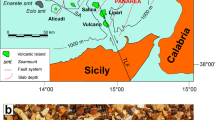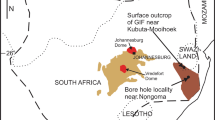Abstract
COSMIC spherules obtained from deep-sea sediments have generally been accepted as extraterrestrial; but their mode of formation has been uncertain. On chemico-mineralogical evidence and the study of polished sections, it is difficult to refute the assumption that the spherules are merely the droplets shed from the fusion crust of a meteorite as it ablates in the atmosphere. We are now re-examining a new spherule collection (diameter > 50 µm) from surface red clay samples used previously1; that is, Atlantic A2 (24°30′N, 64°47′W, 5949-m depth) and Pacific (22°07′S, 115°10′W, 3,060–3,200-m depth). Scanning electron microscopy of 40 ‘stony’ spherules and 25 ‘irons’ has led us to consider a new hypothesis—that the cosmic spherule is a round body in space and those that we find suffer only slight alteration during their grazing flight through the atmosphere. Interesting surface features exist on many of the spherules, both stones and irons, which make it difficult to believe that they have been sprayed from a meteorite. If our hypothesis can be substantiated, then cosmic spherules become important objects in their own right, a cometary origin beingas distinct possibility. We now show some of these surface feature and mention other supporting evidence. From the surface appearance we can classify the spherules into different types and forms, and all forms occur with similar relative frequency in Atlantic and Pacific oceans.
This is a preview of subscription content, access via your institution
Access options
Subscribe to this journal
Receive 51 print issues and online access
$199.00 per year
only $3.90 per issue
Buy this article
- Purchase on Springer Link
- Instant access to full article PDF
Prices may be subject to local taxes which are calculated during checkout
Similar content being viewed by others
References
Hunter, W. & Parkin, D. W. Proc. R. Soc. A 255, 382–397 (1960).
Mason, B. Meteorites (John Wiley, London, 1962).
Brownlee, D. E., Blanchard, M. B., Cunningham, G. C., Beauchamp, R. H. & Fruland, R. J. geophys. Res. 80, 4917–4924 (1975).
Blanchard, M. B. & Cunningham, G. C. J. geophys. Res. 79, 3973–3980 (1974).
Finkelman, R. B. Science 167, 982–984 (1970).
Foley, R. T. J. Electrochem. Soc. 109, 1202–1206 (1962).
Allen, R. O. & Mason, B. Geochim. cosmochim. Acta. 37, 1435–1456 (1973).
Author information
Authors and Affiliations
Rights and permissions
About this article
Cite this article
PARKIN, D., SULLIVAN, R. & ANDREWS, J. Cosmic spherules as rounded bodies in space. Nature 266, 515–517 (1977). https://doi.org/10.1038/266515a0
Received:
Accepted:
Issue Date:
DOI: https://doi.org/10.1038/266515a0
Comments
By submitting a comment you agree to abide by our Terms and Community Guidelines. If you find something abusive or that does not comply with our terms or guidelines please flag it as inappropriate.



